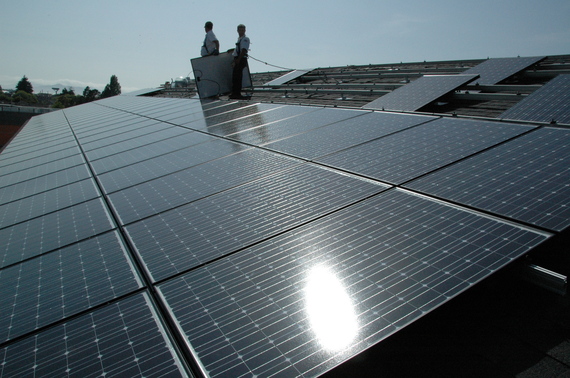
In a 2-1 decision Friday, the U.S. Circuit Court of Appeals for the District of Columbia threw out a Federal Energy Regulatory Commission (FERC) rule authorizing payments to electricity consumers who reduce their electricity usage during periods of high prices, a service known as "demand response."
The majority opinion held that FERC Order 745, which regulates how the Independent System Operators (ISOs) and Regional Transmission Operators (RTOs)Â that operate wholesale energy markets pay demand response providers, constituted regulation of retail sales of electricity, an activity that the Federal Power Act reserves to state regulatory commissions.
While FERC argued that it was only regulating "activities" that impact the wholesale interstate energy markets over which FERC has clear jurisdiction, the court held that such a rationale "could ostensibly authorize FERC to regulate any number of areas, including the steel, fuel, and labor markets."
FERC also argued it had jurisdiction over demand response providers operating in wholesale energy markets because such actors were "direct participants" in interstate markets. The court rejected this argument as well, with the majority writing that the Federal Power Act drew a line around FERC's authoirty, giving states clear authority over retail sales. FERC's "direct participant" rationale would make that distinction meaningless, the court opinion held, as all retail customers are participants in some form or another in interstate energy markets.
"Demand response, simply put, is part of the retail market," said the ruling. "It involves retail customers, their decision to purchase at retail and the levels of retail electricity consumption."
While Order 745 only pertains to demand response participating in wholesale energy markets, the DC Circuit decision could have consequences for the legality of demand response in other interstate markets, including capacity markets where demand response plays a much larger role. According to a statement issued Monday by EnerNOC, the nation's largest provider of demand response resources, only 2 percent of the company's approximately $1 billion in revenues over the last three years derived from wholesale energy market payments subject to Order 745.Â
The ruling could also potentially impact FERC's ability to regulate the market behavior of distributed energy resources, including solar panels, fuel cells, batteries, and other devices connected to lower-voltage distribution lines, which also traditionally fall under the perview of state regulators.
Paying Too Much for Demand Response Distorts Markets
While the Circuit Court ruling primarily hinges on jurisdictional questions, the majority opinion also had harsh words for FERC's decision to require ISOs and RTOs to pay demand response providers the full wholesale market rate, known as the locational marginal price, or LMP.
"If FERC thinks its jurisdictional struggles are its only concern with Order 745," the Court wrote, "it is mistaken." The majority said they "would still vacate the Rule if we engaged the Petitioners’ substantive arguments."
Those "substantive arguments" are well summarized in an amici curiae filed by 21 leading energy economists, including UC-Davis's James Bushnell, Harvard's William Hogan, Johns Hopkins's Benjamin Hobbs, and MIT's Richard Schmalensee. The economists argue that paying demand response providers the full LMP "is inconsistent with basic economics."
Demand response payments are necessary because few retail customers actually recieve wholesale price signals and thus have no incentive to reduce consumption when power is scarcer and more expensive or increase consumption when power is cheap and plentiful. That makes energy markets much less efficient than they should be.
"Properly structured incentives can provide appropriate price signals to curtail usage when it is economically efficientâ€"even if retail rates are otherwise constant," the economists write. "The key demand-response question," the economists argue, "asks how much to pay retail customers to forgoe purchasing electricity at a fixed price when wholesale prices climb."
FERC's Order 745 is based on the rationale that "paying demand response resources the LMP in all hours will compensate those resources in a manner that reflects the marginal value of the resource to each RTO and ISO, comparable to treatment of generation resources."Â
This is a reasonable idea on its face, but paying demand response providers the full LMP fails the test of basic economics and can introduce significant distortions into energy markets, according to the amicus brief.
The economists argue that FERC's goal should be "to replicate market forces" by asking what would happen if electricity consumers were exposed to the real wholesale market price, or barring that, if a customer with a fixed price contract to purchase electricity resold energy at the prevailing wholesale market price.
In either case case, the retail customer would have "an incentive to forgo energy consumption only when doing so is more profitable than using the electricity to produce goods and services (i.e., when non-production is more efficient than production)."
Consider a manufacturer or widgets that cost 40 cents each to produce, including 30 cents to pay for electricity, and have a market price of $1. The widget maker earns 60 cents profit per widget and, as the economists explain, "Society gains handsomely when the widget-maker converts 40 cents in inputs into a product consumers value at $1."
But what happens once the market price of electricity rises, increasing electricity's contribution to produciton costs to 91 cents per widget? At that point "society is better off if the widget-maker stops production" as "the retail cost of making a widget (labor and materials at 10 cents per widget plus the 91-cent per-widget electricity cost) exceeds the ($1) market price."
This is the efficient market price signal that demand response markets should be trying to replicate when electricity consumers are not exposed to the fluctuating wholesale market price.
Unfortunately, paying demand response providers the full LMP not only pays too much for demand response, it also introduces economic distortions which can causes electricity consumers to "forgo other productive economic activity."
If demand response earns the full LMP, the widget-maker will stop producing once the LMP reaches 61 cents per widget, not 91 cents, illustrating the distortionary impact of FERC's rule.
"At that point," the economists explain, "the widget-maker can earn more by doing nothing: It avoids its costs (30 cents in electricity at its contract rate and 10 cents per widget in production costs, assuming production costs fall to zero when production ceases), and it collects 61 cents in demand-response payments, more than the net profit of 60 cents from making widgets."
"That result clearly makes society worse off," the economists argue. Society would still benefit if the widget-maker produced widgets with electricity at 61 cents per widget, as total production costs would be only 71 cents and society values those widgets at $1â€"resulting in a net societal gain of 29 cents per widget.Â
Unfortunately, that's exactly what FERC's Order 745 would do. Our hypothetical widget-makerâ€"and all other demand response actorsâ€"would be incentivized to reduce electricity consumption and take the full LMP price as payment long before the economically efficient price signal would encourage them to cut back on electricity consumption.
A Distortionary Subsidy for Self-Generation
Paying full LMP also distorts incentives for electricity consumers to install distributed generation behind the meter and "self-generate."
In an efficient system, an owner of distributed generation "would self-supply only when it costs less than purchasing electricity" from the grid. Thus, if self-generation costs 60 cents per widget, we wouldn't want our widget-maker to self generation until electricity prices hit 60 cents per widget.Â
Under FERC's approach, however, owners of distributed generation would self-supply much earlier. As the economists explain:
"[I]f his retail electricity rate is 30 cents per widget, the widget-maker will self-supply when LMP hits 31 cents per widget. His profit from self-supplying is the 30 cents per widget saved by not buying electricity from the grid, plus the 31 cents per widget (LMP) he recieves as a demand-response incentive for not buying the electricity from the gridâ€"1 cent more than the 60 cents it costs to self-supply. Thus, even though the economic cost of self-generating electricity is higherâ€"60 cents per widget rather than the LMP cost of 31â€"the widget-maker will self-supply."
"The absurdity of that result is made especially clear," the economists write, if one considers how much a generator would earn if it were simply placed on the other side of the meter and bid into wholesale markets. If generation costs were 60 cents, the generation owner would only earn a profit once the LMP rises above 60 cents. But simply by moving behind the meter, that same generation owner can earn far more under FERC's rule, netting the 60 cents from the LMP and avoiding paying the 30 cents per widget he would have otherwise paid to purchase electricity from the grid.
FERC's Order 745 "thus provides a subsidy for self-supply and for refusing to share generated electricity with others."
Demand Response is Selling a "Call Option" Not a "Negawatt-hour"
The problem with FERC's Order 745 is that it treats demand response providers as functionally equivalent as wholesale generators of electricity.
Demand response providers are said to sell a "negawatt-hour," which is considered the equivalent to generating a real kilowatt-hour. As the economists explain, this rationale "ignore[s] the fact that retail customers who curtail consumption both receive LMP and avoid the cost of purchasing electricityâ€"a benefit electricity generators do not receive."
The economists argue that demand response providers should be viewed not as the equivalent of generators selling electricity but as the owners of a "call option" to purchase electricity at the retail price:
"For example, if a consumer has a right to purchase electricity at a particular rate, it might sell that electricity to another consumer at the existing LMP. If our widget-maker contracted to purchase electricity at 30 cents per unit and LMP rose to 91 cents per unit, he could stop production, exercise the implicit option to buy electricity for 30, sell it at 91, and net a profit of 61 cents per unit."
The appropriate and economically-efficient method for compensating demand response providers is thus to pay these providers the current LMPÂ minus the retail rate. The economists dub this approach "LMP-G," and it appropriately mimics the efficient market results that would be obtained if electricity consumers were exposed to the real wholesale price of electricity.
Indeed, while FERC Order 745 attempts to put generators and demand response providers on an equal playing field by paying each the same LMP price, the LMP-G approach is actually the best way to equalize incentives between generators and consumers.
The "crucial fact" is that "a generator’s profit is not the LMP it receives. It is the LMP it receives minus the costs it incurred to deliver power," write the economists.
Likewise, a demand response provider should recieve the LMP minus the cost of purchasing the call option which gives it the right to cut back its consumption and sell that option in the marketâ€"that is, the retail price of electricity. "Like other call options, the amount the demand-response provider receives must be offset by the strike price (here, the retail rate)."
"Failing to subtract the retail rate, by contrast, allows the consumer to sell its electricity at full rates without ever having bought it," the economists conclude. "And that induces consumers to sell load reductions even when it is more efficient for them to purchase electricity."
Legal Battle Continues
The DC Circuit Court is unlikely to be the last stop for the debate over FERC's authority and the appropriate compensation for demand response. Friday's ruling is expected to be appealed to the Supreme Court soon, and given the important jurisdictional issues at stake, will likely be granted certiorari.
Still, regardless of whether state utility comissions or FERC ultimately oversees markets for demand responseâ€"and, I might add, markets for services provived by distributed generationâ€"the 21 economists writing on FERC's Order 745 offer a clear guide for how to structure efficient and fair markets for demand response services.
Further Reading

 According preliminary data published in the U.S. Energy Information Administration’s latest
According preliminary data published in the U.S. Energy Information Administration’s latest 




 Greentech Media
Greentech Media













